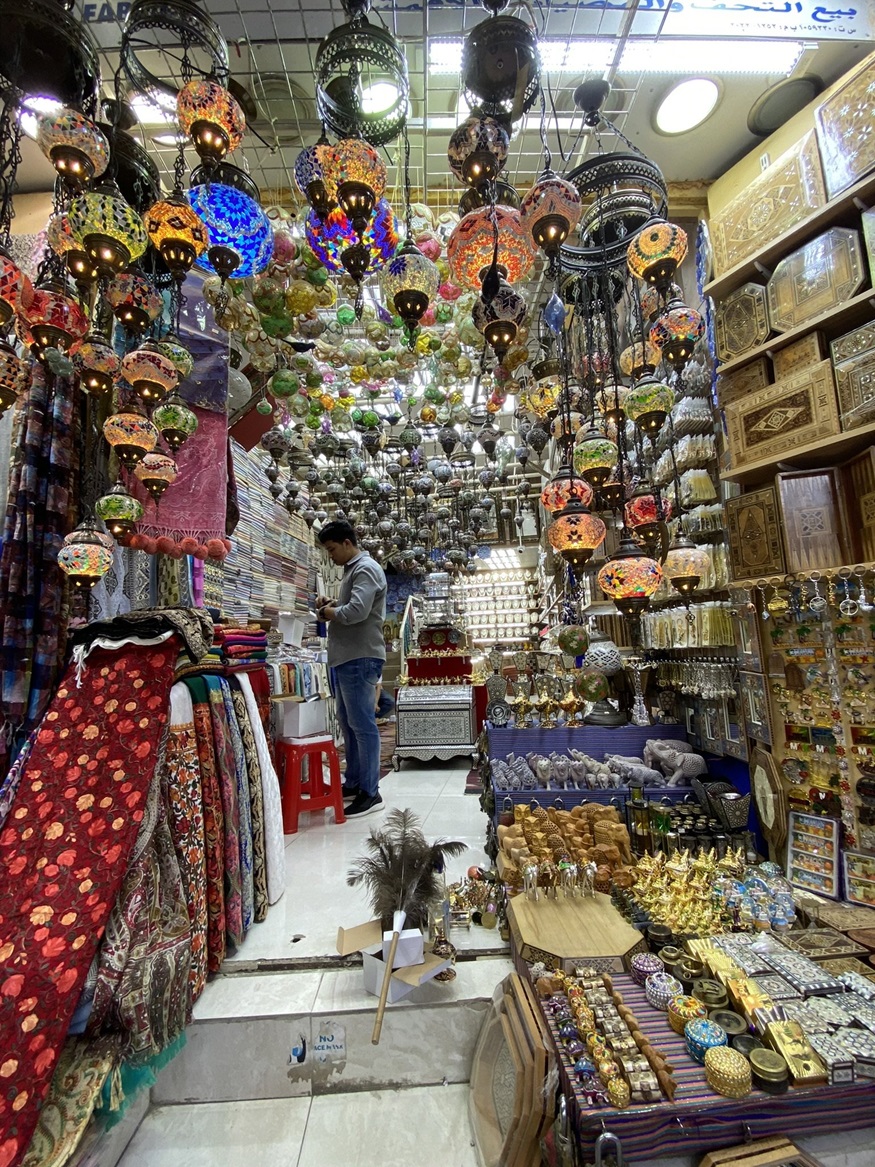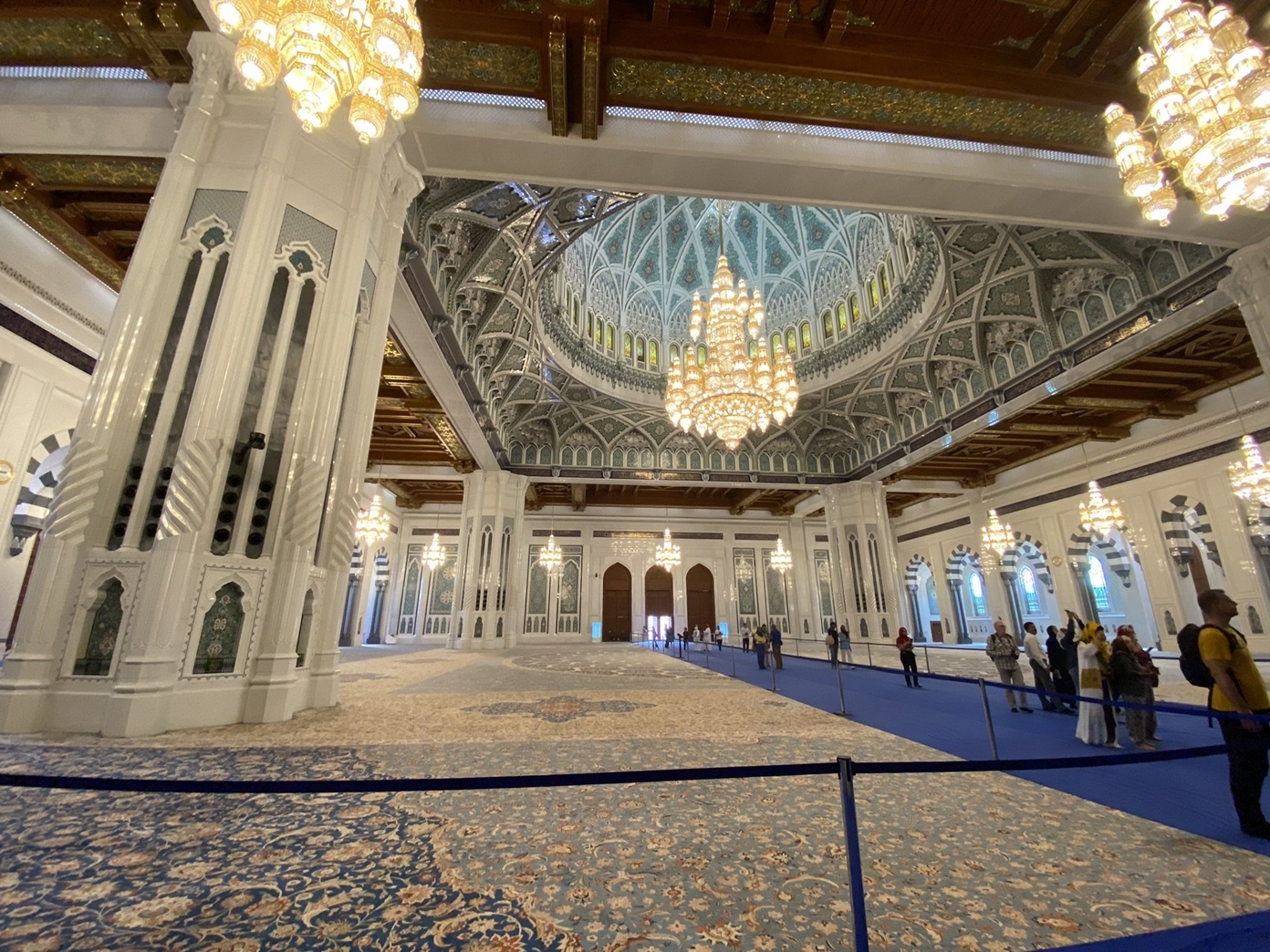
Bright white buildings clutter valleys and flat land, fenced between the parched, brown, craggy Al Hajar Mountains and the Arabian Sea. The whiteness makes it appear recently built, but Muscat has been a trading port since the 1st century AD.

Bait Al Zubair Museum gives an insight to Oman’s history and culture. I learn of ancient aflaj irrigation systems; centuries-old rose-water production; the harvesting of frankincense; and of age-old daggers, khanjar, now ceremonial.

High above a marina, I watch a dhow head out into the Gulf of Oman’s azure waters. In front of the impressive building housing the National Museum, one rests on Al Bustan roundabout, one of many featuring sculptures. I peer through black metal gates at the Sultan’s Palace, built in 1972. Towering, futuristic blue and gold pillars, like giant golf tees, support a flat roof. Sprawling stone buildings surround it, and marble pavements are so glossy they appear coated in water. Stone watchtowers and walls follow the ridgeline of mountains beyond. Behind the palace complex, two reddish-stone forts built by the Portuguese in 1705, Al-Jalali and Al-Mirani, spread up hills either side of the old city’s port.
We drive along the waterfront corniche to Muttrah Souq, opposite the harbour. The roofed souq’s wide alleys, hazy with burning frankincense, are a kaleidoscope of colour; crockery, lamps, ornaments, cashmere scarves, jewellery, ornate wooden chests ... Baskets brim with nutmeg, indigo, yellow sulphur, lavender, saffron, cloves, star anise, red peppers, black peppers, green peppers, cinnamon, coriander, ginger, cumin, chillies and more.

Heart pounding, I climb stairs to the restored, mountain-ridge Muttrah Fort nearby, built around 1507 and enlarged in the 18th century by the Portuguese. From a tower where a cannon sits, I look out to the still harbour and over the white city. The sun sinks, turning surrounding mountains red, until they become a jagged silhouette.
We wander — alongside families — the marble-tiled, lamp-lit promenade, cooling in the sticky humidity. On a hill above the road a giant incense burner sculpture resembles a white spaceship. We drive, hotel-bound. In the darkness, mosque roofs glow golden, minarets’ tips like lit candles.

From a 50m-high central dome hangs an 8.5-tonne, 14m-high Swarvoski crystal chandelier, containing 1122 bulbs and decorated with 24k gold. Spread below is a 60m×70m carpet, woven with golden dome shapes encasing intricate designs on a deep-blue background, which took 600 women four years to weave by hand. White Italian Carrara marble forms pillars and walls inlaid with murals of Middle Eastern design in blues and greens, and stained glass windows. Marking the direction of Mecca, the Muqarna is an alcove richly decorated with mosaicked geometric shapes in blue, gold and turquoise. Opulence abounds at the Amouage Perfume Factory and Visitor Centre. Founded in 1983 by the royal family, its perfumes were gifted to royal visitors from around the world by Sultan Qaboos, ruler from 1970-2020, and were unavailable to the public until 1998. Plated with 24k gold, original bottles — in the shape of a khanjar hilt for men, or a square bottle with a gold mosque-like dome for women — are displayed. Created in 2008, Zadora bottles are Amouage’s rarest; crystal with a rose quartz, 18-carat gold and diamond-encrusted cap, and selling for a mere $US150,000 ($NZ263,000).
It is apparently the world’s only perfume factory where the entire manufacturing process can be viewed by the public. I learn oil from Omani ingredients is extracted in France. Glass bottles holding those oils clutter shelves. Stainless steel tanks contain fragrances, a mixture of oils and ethanol, which sit for two weeks to six months. In the elegant store, I sniff scents, clearing my nose by smelling coffee beans between them. The guide explains what each comprises. Ambergris, a byproduct of sperm whales’ diets, washes up on Oman’s shores and gives musky, sweet and earthy notes; there’s Omani Hojari frankincense; one of the rarest roses, Rock Rose, grown in the country’s mountains; and oud, sap from the rare agarwood tree aged 22 years before being used. Other perfumes include oils from cherry blossom, sandalwood, gardenia, cloves, pear, saffron, vanilla, jasmine, coffee and cocoa beans. They’re all way out of my price range!

A horn sounds from the boat. I flipper back. Whale sharks have been spotted. We’re off in search, and get lucky. The world’s largest fish swim just below the surface. They’re perhaps 5m long, their grey skin dotted greenish-blue, mouths at the front of their wide, rounded heads rather than the undersides. Tiny fish feed off barnacles on their backs; they appear unbothered by schools of snorkellers swimming with them. An incredible sight.
If Muscat is anything to go by, I’m looking forward to exploring more of Oman.












